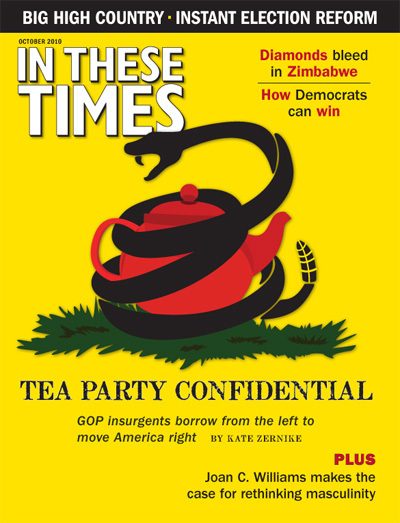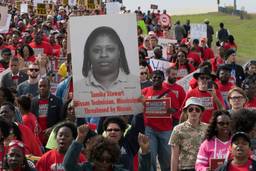Midterm: Create Jobs, Contain Losses
Democrats need to embrace populism before it’s too late.
David Moberg

Congressional Democrats will lose ground this fall. Only the pathologically optimistic could expect otherwise. But an important question remains: What can they do now to minimize the damage?
Their best hope – though still a politically complex gamble – lies in bringing to Congress and to the campaign trail ambitious proposals aimed at creating millions of short- and long-term public service and private sector jobs. By using government to help average Americans and restrain job-destroying banks and big corporations, Democrats can counter the faux populism of the right.
As policy, it’s a no-brainer. Hundreds of leading economists have called for a major new stimulus – including Nobel Laureates Paul Krugman and Joseph Stiglitz, former Clinton economic advisor Laura Tyson, former McCain advisor Mark Zandi of Moody’sEconomy.com, and outgoing Obama economic adviser Christina Romer.
But Democrats are divided. Many conclude, according to one progressive lobbyist, that a stimulus may be “ultimately what’s needed, but politically it won’t help.”
In his run for Senate in Pennsylvania, Joe Sestak, Netroots hero and primary winner against Sen. Arlen Specter, has staked out the progressive high road. Unemployment is high, he says, not because the stimulus didn’t work but because it was too small. He proudly defends democratic jobs legislation and wants to “stabilize the economy through [an] aggressive stimulus plan.”
Polls in late August showed him trailing former Rep. Pat Toomey, ex-president of the ultra-conservative Club For Growth, but Sestak still may bound back. He had just begun running tough populist ads against Toomey as “the champion for Wall Street,” who says corporations should not pay taxes.
In another tight race, Wisconsin Democratic Sen. Russ Feingold is running his own brand of populist campaign as “a Senator on your side” who “stood up to big corporations,” fought “unfair trade agreements” and opposed legislation that “let Wall Street run wild.” Yet while he defends the first stimulus, he now advocates deficit reduction and opposes a second stimulus.
“The situation is dire enough that Congress should spend every waking minute on the job crisis,” says AFL-CIO Government Affairs Director Bill Samuel. “But enough Democrats are worried about giving the appearance that they’re spending money and an absolutely united Republican caucus is against spending to create jobs.”
Despite the Senate rules roadblock and her own blue dog opposition, Speaker Nancy Pelosi is anxious to push hard for any viable jobs bills. But many House Democrats feel burned by the Senate’s inaction on bills they considered tough votes.
Prospects are dim for significant new job creation legislation. Nonetheless, it’s important to push this strategy to its limits, even if it can only reduce the losses.
Blame-the-incumbent syndrome
The historical odds have been against Democrats from the start. Only twice since 1900 has a first-term president’s party not lost seats in Congress in his first midterm election.
Also, nothing is a better predictor of the fate of the party in power than the unemployment rate, now stuck around 9.5 percent with little sign of a near-term turnaround. And partly as a result, Obama’s approval rating has dropped sharply, to about 44 percent (though still outperforming Clinton, Reagan and Carter at this point in his tenure).
Political strategists estimate that as many as 80 incumbent Democrats are in trouble, and Gallup polls of voters’ preferences between generic party candidates turned sharply against Democrats in late summer. Despite political blame often assigned to Obama, public approval of the Republican party is lower – about 35 to 37 percent in recent polls. And surprisingly, given their electoral upper hand, popular approval of the Republican party is lower still, about 30 to 33 percent.
Voters have not necessarily fallen in love with Republicans. They’re just deeply disappointed with Democrats.
Four anticipated voting trends work against Democrats this fall. These include high Republican enthusiasm (much of it backlash against Democrats), a dramatic shift of independents from 2008 toward Republicans, low enthusiasm in the Democrats’ electoral base, and a steep drop-off of Democratic voters from 2008 (especially the young people and minorities whom Obama energized).
Democrats will press Obama’s message that Republicans, not Democrats, drove the economy off the road, and voters shouldn’t give them back the keys. Indeed, Democratic policies have significantly reduced unemployment from what it would have been, according to an August report by the nonpartisan Congressional Budget Office. But as Roger Hickey, co-director of the progressive policy group, Campaign for America’s Future (CAF), says, “For a lot of people, the car is still in the ditch.”
Worse yet, there’s a growing plurality blaming Obama and his stimulus policies, not Bush and his tax cuts for the rich, for both the recession and budget deficits (though people in an August CAF poll listed the wars in Iraq and Afghanistan as the leading deficit cause). And despite legislative accomplishment on healthcare, financial reform and economic stimulus, most of the measures Democrats were able to pass failed to inspire the party’s core voters. At the same time, a National Public Radio poll early in the summer showed voters in highly competitive congressional districts agreeing by roughly 52 percent to 40 percent margins with Republican, not Democratic, arguments about what those accomplishments represented.
Federal deficit disorder
Democrats will find it tough to run solely on either Bush’s failings or Obama’s accomplishments, even though they must ramp up that contrast, as the AFL-CIO political program does.
Yet a rising preoccupation with deficits constrains Democrats, especially in dealing with the top issue on voters’ minds – jobs and the economy. White House fears of attacks for running large budget deficits led them to trim back their stimulus proposals, and the limited success of their job creation policies makes it easier for Republicans, however wrongly, to portray the resulting deficits as wasteful.
Voter concerns with deficits are real but malleable. In a Democracy Corps/CAF poll in late August, voters expressed equally warm responses to reducing the deficit dramatically and to investing in new industries to rebuild the country. When asked to choose which is more important, a slim majority picked budget cuts (but not in Social Security or Medicare) to reduce deficits over new investment to foster new industry. But given a different choice, the majority reversed to support a plan for both investment and deficit reduction over budget cuts.
“The balanced budget support is a protest message, not an answer that takes us any place,” says CAF co-Director Robert Borosage.
That protest reflects a profound misunderstanding of federal government budgets as essentially household budgets writ large. Anti-government Republicans cynically exploit deficit politics (opposing deficits from an Obama stimulus, not from Bush tax cuts or misguided wars). But since the Clinton years, Democrats have also embraced balanced budgets. Now they’re vulnerable to a confused public, which by 47 to 33 percent thinks reducing the deficit now will lower unemployment – precisely the opposite of what most economists would argue.
This protest also stems from deep mistrust of government. According to a July study from the Center for American Progress, over the past decade confidence in government has sunk to a record low (dropping especially among the white working class). But most Americans want better, not smaller, government that actively works on energy, education, poverty and other issues, they found.
Obama has already given up too much ground to deficit hawks by establishing a deficit commission that is likely to propose cuts in Social Security benefits that are not needed and will be politically disastrous for Democrats.
“The economy is the most important issue people are worried about,” Hickey says. “The White House and Congress should stop worrying about getting things passed, declare an emergency and come forward with a jobs plan and challenge the Republicans.” But beyond an October 2 jobs rally in Washington, progressives have few levers to move the party in their direction.
Populism, not centrism
The White House is pushing some minor job bills, including Senate approval of small business tax credits, and Pelosi is promoting a “Make It In America” package of aid to domestic – especially “green” – manufacturing.
Democrats could also promote jobs through public service work and private sector training, as Rep. George Miller (D-Calif.) proposes; federal direct hiring (as in the New Deal’s Works Progress Administration); more infrastructure projects (or create an infrastructure bank); pending reauthorization of highway or clean water acts, or wage subsidies to workers who are retained at reduced hours rather than laid off.
Perhaps little of this could pass in the upcoming short fall session, but core Democrats might feel more motivated if Congress tried. “We see a lack of enthusiasm and a sense of disappointment that the economy is still reeling with no end in sight,” AFL-CIO political director Karen Ackerman says. “It’s why people feel a sense of discouragement. Our job is to help people focus on this election as a choice and show the differences among candidates.”
“The stronger Democrats are on investing and creating jobs, the stronger they will be in the election,” she says. “[Our members] have to be shown that Democrats understand them and are on their side.”
Voters brought into the electorate by Obama’s candidacy – drawn mainly from ethnic minority groups, unmarried women and youth – are likely not to vote this year. But as groups that are both more in need of jobs and strong supporters of government (especially true for the “Millennial” generation), a bold new jobs program could get more of them to the polls.
While little may dampen Republican enthusiasm (except some bad or very fringy candidates), some independents could be won over. Democrats could make it clear why deficits are needed now, but can be reduced with economic growth and higher taxes on the rich. They could better show that job creation plans work and that working people benefit – playing up support for manufacturing, which has high support across diverse political constituencies.
A strong populist message – against banks and corporate influence – could also counter the right-wing’s anti-government, populist appeal and help Democrats develop a more compelling narrative about the direction they want to take the country.
“The thing I’ve been trying to convey to people is that this isn’t an anti-Democratic, anti-incumbent sentiment in this election,” says Darcy Burner, executive director of the Progressive Congress Action Fund. “It’s anti-corporate. We’re seeing populism on the left and right, and strong populist candidates are doing better. … A move to the center is the kiss of death. Centrist in D.C. means pro-corporate, and becoming pro-corporate doesn’t help.”
Similarly, Jim Dean, chair of Democracy for America, an organization of the Democratic left, says, “People are angry about the Washington way of doing business, the outsized influence of big business.” And Tim Carpenter, national director of Progressive Democrats of America, says if he were party chair, “I’d forget about moving to the center and deferring to the Blue Dogs, but play to strength rather than attack my base.”
In some districts, Democratic candidates are clinging to the centrist raft. In an Illinois congressional district including suburban and rural counties west of Chicago, Republicans have long ruled, most recently ex-Speaker Dennis Hastert. Democratic businessman Bill Foster won in 2008, but is now running as “the second-most centrist” member of the House, who represents his district, not his party. His campaign touts his breaks from the party line on key issues, such as cap-and-trade legislation on global warming and his emphasis on balancing the budget.
But Rep. Alan Grayson, freshman Democrat from Orlando, Fla., is running a strongly populist “Us v. Them” campaign against a right-wing Republican who favors covenant marriage. Denouncing Republicans for their “heartless,” “Marie-Antoinette” policies, Grayson, according to his campaign, wants “to do more” to create jobs, and not only through tax cuts.
Whatever individual candidates may do, the political fortunes of the Democratic Party as a whole – including even the centrists and conservatives – will be better served this year and in the future by focusing on strong job creation legislation and a populist message that puts the party with working people, not monied people of power. n
David Moberg, a former senior editor of In These Times, was on staff with the magazine from when it began publishing in 1976 until his passing in July 2022. Before joining In These Times, he completed his work for a Ph.D. in anthropology at the University of Chicago and worked for Newsweek. He received fellowships from the John D. and Catherine T. MacArthur Foundation and the Nation Institute for research on the new global economy.









